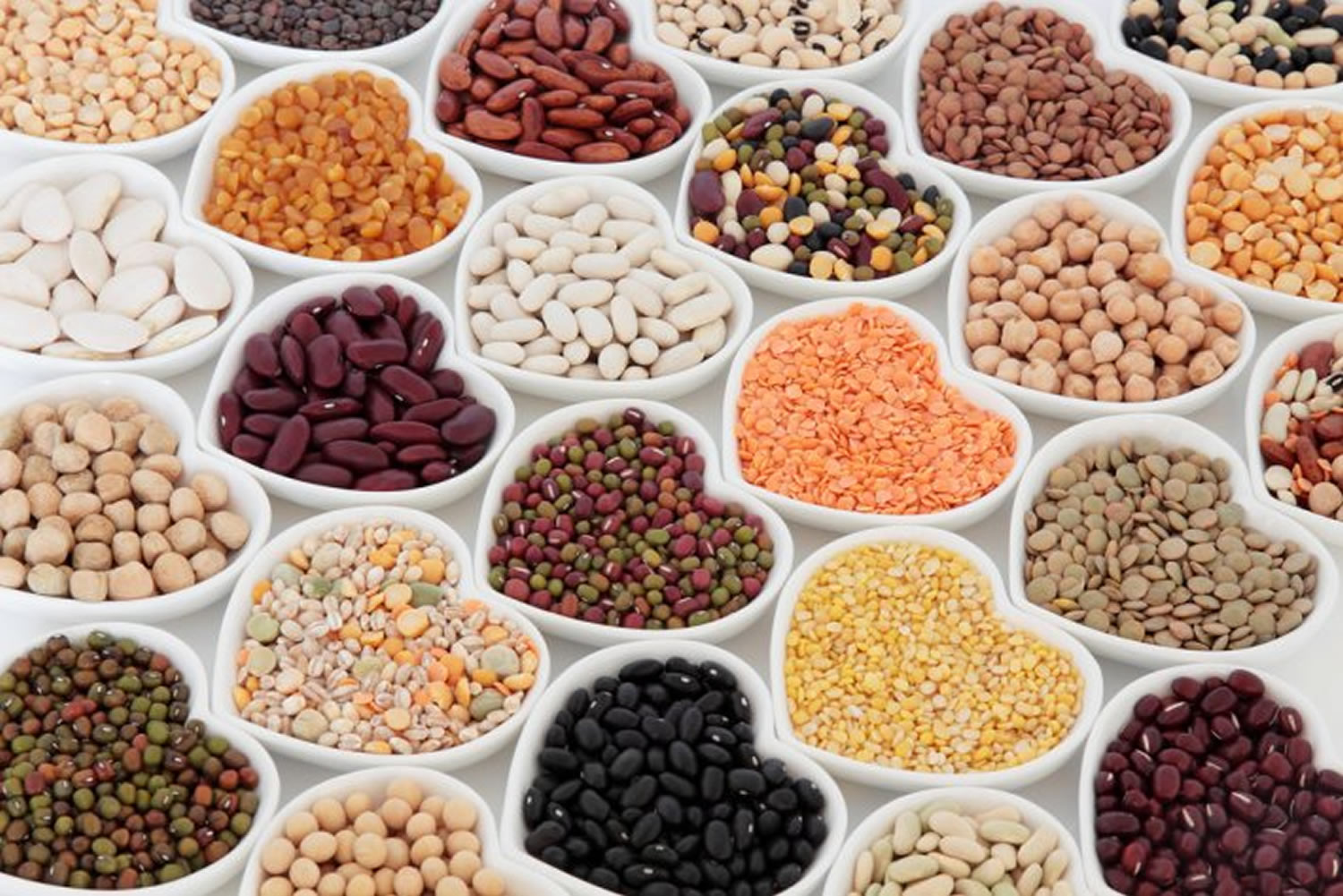
Contents
- What are Legumes ?
- What are Beans
- Bean Nutrition Facts
- Dry Beans Provide Complex Carbohydrates
- Dry Beans Provide Beneficial Dietary Fiber
- Dry Beans Are A Source of Plant-based Protein
- Dry Beans Contain Essential Vitamins and Minerals
- Beans & Health Overview
- Soy Bean
- Table 3. Soy (Soya or Edamame) Bean Nutrition Content
- Soy-Based Infant Formula
- Health Effects of Soy
- Peanuts
- Table 4. Peanut (Raw) Nutrition Content
- Peas (Pisum sativum)
- Table 5. Peas (Green Raw) Nutrition Content
What are Legumes ?
Legumes include kidney beans, pinto beans, white beans, black beans, garbanzo beans (chickpeas), lima beans (mature, dried), split peas, lentils and edamame (green soybeans). Legumes are an inexpensive and healthy source of proteins, potassium, and complex carbohydrates, including dietary fiber. In addition, they provide other nutrients that also are found in seafood, meats, and poultry, such as iron and zinc. They are excellent sources of dietary fiber and of nutrients, such as potassium and folate that also are found in other vegetables. Because legumes have a similar nutrient profile to foods in both the protein foods group and the vegetable group, they may be thought of as either a vegetable or a protein food and thus, can be counted as a vegetable or a protein food to meet recommended intakes. Green peas are similar to starchy vegetables and are grouped with them.
- On average, legumes contain about 20-25% protein by weight on a dry basis, which is 2-3 times more protein than wheat and rice. However, they tend to be low in the essential amino acid methionine, and sometimes tryptophan.
- Legumes are also a very good source of dietary fiber, which is important for maintaining healthy bowel function.
- The content of total carbohydrate, including complex carbohydrates, ranges from 65-72% by weight on a dry basis, of which 85% is composed of starch, while dietary fiber constitutes anywhere from 10-20% of the weight of dried legumes 1.
There are two main forms of dietary fiber in food:
- One is insoluble fiber comprised of complex carbohydrates, such as cellulose, that are insoluble in the gastrointestinal fluid. This form of fiber is not broken down by gut bacteria, acts as a bulking agent, and is effective at reducing constipation.
- The other form of fiber is soluble in gastrointestinal fluid, producing a thick, viscous liquid similar to honey. Soluble fiber is readily metabolized by gut bacteria, which convert much of it into small molecules called short-chain fatty acids. The cells lining the colon obtain about 60-70% of their energy from short-chain fatty acids 2.
Although resistant starch does not increase the viscosity of the gastrointestinal fluid, it is one of the best sources of short-chain fatty acids, helping to maintain the health of colonic (large intestine) cells.
- Since resistant starch is not metabolized in the small intestine it reduces the amount of glucose released into the blood, thus lowering the demand for insulin while also reducing the caloric density of food 3.
- Foods that contain significant levels of resistant starch increase satiety and have a lower glycemic index, producing a smaller rise in blood glucose than high starch foods that contain very little resistant starch, such as baked potatoes, rice, and white bread 4. Clearly, not all carbohydrate is alike.
Two English researchers, Hans Englyst and John Cummings discovered that not all starch is rapidly digested to glucose in the small intestine 5.
- They found that some starch is resistant to digestion and passes into the large intestine where much of it is used as a food source by the healthy bacteria living in our colon. Englyst and Cummings named this previously unknown form of starch “resistant starch” and concluded it acts similar to dietary fiber.
- Substantial research since their discovery has confirmed that resistant starch functions much like dietary fiber in food 6.
Why is some starch resistant to digestion ?
A small portion of it is physically inaccessible to digestive enzymes. But most of it is resistant due to the chemical structure of starch. Starch is composed of two molecules called amylose and amylopectin.
- Amylose is a linear chain of glucose molecules linked end-to-end.
- Amylopectin is a much larger molecule with numerous branches of short chains of glucose molecules linked to a main chain like the branches of a tree growing from the trunk.
The starch molecules, especially amylose, form crystalline regions that are resistant to digestion by the starch digesting enzymes in our body 6. Compared with other high starch foods like corn, wheat, and rice, the starch in legumes is very high in amylose, comprising up to 40% of the starch, making it more resistant to digestion.
It is important to realize that resistant starch is not a distinct molecular structure like glucose or cholesterol, but a new concept developed to explain why some starch is not digested 7.
The amount of resistant starch reported in foods is therefore highly dependent on the method used to analyze for resistant starch. In 2000 a standardized test for determining the content of resistant starch in food was approved by AACC International 8. The numbers reported in this article were determined by this method 9.
Legumes are one of the best sources of resistant starch. Raw, dried legumes contain about 20-30% resistant starch by weight 10. That means almost half of the starch in raw legumes is resistant to digestion.
If cooked legumes contained as much resistant starch as raw legumes we would have a very difficult time digesting them. As with all high starch foods, when legumes are cooked in boiling water large portions of the crystalline regions are destroyed, reducing the amount of resistant starch. But since legumes are so high in amylose, a smaller amount of resistant starch is destroyed by cooking than in other foods because some forms of crystalline amylose are stable even in boiling water 7.
- Fully cooked legumes contain only about 4-5% of their total weight (on a dry basis) as resistant starch, regardless of how long they are cooked.
- Cooling the cooked legumes for up to 24 hours in the refrigerator increases the level of resistant starch to 5-6% of the total weight (dry basis) by allowing some of the starch molecules to recrystallize. Canned whole beans contain about the same amount, as do canned refried beans 9.
This may not seem like much resistant starch, but it is still 4-5 times higher than other starchy foods such as white bread and potatoes (see table 1 below). This is certainly enough to have a significant impact on the formation of short chain fatty acids, glycemic index, reduced insulin response, satiety and caloric content 11. In sum, legumes are a healthy choice not only for their high content of protein and other nutrients, but also because they contain some of the highest levels of resistant starch of any food.
Table 1. Starch, Resistant Starch and Glycemic Index Levels
| Food | Starch* | RS* | Glycemic Index**12 |
| Potatoes, baked | 94% | <1% | 93 |
| White bread | 88% | 1% | 70 |
| Black beans, boiled | 60% | 5% | 30 |
| Pinto beans, boiled | 61% | 5% | 39 |
* Weight percent on dry basis
** A glycemic index below 55 is considered a low G. I. food 12.
One study showed that eating approximately one daily serving of beans, chickpeas, lentils or peas can increase fullness, which may lead to better weight management and weight loss 13.
Beans, peas and lentils are all legumes and are among the most versatile and nutritious foods available. Legumes are typically low in fat, and high in fiber, folate, potassium, iron and magnesium. Legumes (predominantly soybeans and peanuts [Arachis hypogeae]) provide more than 35% of the world’s processed vegetable oil and soybean and peanut are also rich sources of dietary protein for the chicken and pork industries 14. Beans and other legumes can be a healthy substitute for meat, which has more fat and cholesterol. Many of the most health-promoting and disease-reversing diets ever studied emphasize high bean and legume consumption.
What are Beans
All types of beans—including black, cranberry, Great Northern, dark red kidney, light red kidney, white kidney, navy, pink, pinto, and small red—are good sources of protein, excellent sources of fiber, and naturally fat-free, sodium-free, and cholesterol-free. Many types are also good sources of potassium 15.
Beans are rich in phytonutrients and antioxidants and are an excellent addition to a varied, healthy diet. The U.S. Dietary Guidelines for Americans 16 recommends eating about 3 cups of legumes, including beans, per week. If you eat about ½ cup of beans every day, you’ll meet the weekly Dietary Guidelines for legumes.
Beans contain a multitude of nutrients that are known to be health-promoting:
- Ergothioneine, shown to protect DNA
- Folate, important for maintaining healthy homocysteine levels
- Magnesium, associated with an overall decreased risk of mortality
- Iron
- Phytates, now believed to promote bone health, decrease the risk of cancer and even force cancer cells to dedifferentiate back towards being normal cells
- Potassium, an essential mineral that may be protective against stroke
- Protein
- Soluble fiber, associated with decreased risk of breast cancer, colon cancer, inflammatory bowel disease risk, and stroke, as well as slowed progression of heart disease and treatment of constipation
- Vitamin B6, important for eye health
- Zinc, important for male reproductive health
In fact, beans are so health promoting that their consumption is now believed to be the single most important predictor of longevity among older populations around the world.
Black beans appear to be slightly more antioxidant-rich than pinto beans. Lentils (red lentils more than than green ones) come in second after black beans for antioxidant content. Tempeh is a whole soybean food and as such is one of the healthiest forms of soy.
Bean Nutrition Facts
Table 1. Data based on ½ cup servings of beans that have been cooked from the dry form and drained of cooking liquid. Canned beans will contain more sodium.
| Type of Bean | Bean Photo | Calories | Protein (g) | Fat (g) | Total Carb. (g) | Dietary Fiber (g) | Sodium (mg) | Potassium (mg) |
|---|---|---|---|---|---|---|---|---|
| Black |  | 114 | 8 | 0.5 | 20 | 8 | 1 | 305 |
| Cranberry |  | 120 | 8 | 0.4 | 22 | 9 | 1 | 342 |
| Great Northern | 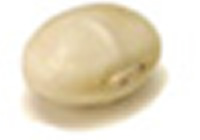 | 104 | 7 | 0.4 | 19 | 6 | 2 | 346 |
| Navy | 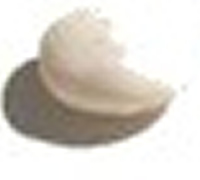 | 127 | 8 | 0.6 | 24 | 10 | 0 | 354 |
| Pink | 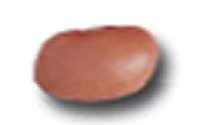 | 126 | 8 | 0.4 | 24 | 5 | 2 | 429 |
| Pinto | 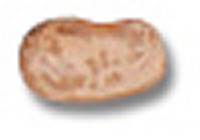 | 122 | 8 | 0.6 | 22 | 8 | 1 | 373 |
| Light Red Kidney | 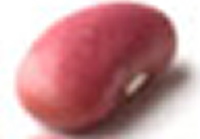 | 112 | 8 | 0.4 | 20 | 7 | 2 | 357 |
| Dark Red Kidney | 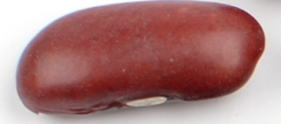 | 109 | 8 | 0.2 | 19 | 8 | 4 | 335 |
| White Kidney | 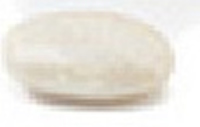 | 124 | 9 | 0.3 | 22 | 6 | 5 | 502 |
| Small Red | 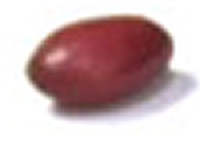 | 110 | 6 | 0.5 | 19 | 6 | 1 | 371 |
(Source 15).
There appears to be little difference in nutrient profiles among cooked, sprouted and canned beans, but some canned beans may contain up to one hundred times more salt than beans prepared at home. It’s never too late to accrue health benefits from switching to a healthier diet with lots of legumes and lifestyle with lots of exercise.
One should also be aware that the plastic linings in bean cans produced by certain companies contain BPA (bisphenol A, an industrial chemical that has been used to make certain plastics and resins often used in containers that store food and beverages).
Dry Beans Provide Complex Carbohydrates
- Complex carbohydrates, also referred to as dietary starch, are made of sugar molecules strung together like a necklace. Complex carbohydrates are typically rich in fiber.
- The majority of the calories in dry beans come from carbohydrates in the form of starch, resistant starch (digested by beneficial bacteria in the gut), and small amounts of non-starch polysaccharides (also digested by beneficial gut bacteria).
- Being rich in complex carbohydrates, as well as a good source of protein, beans have a low glycemic index. This makes them an ideal food for the management of insulin resistance, diabetes and hyperlipidemia 17, 18.
- Beans contain some complex sugars called oligosaccharides, which are non-digestible, fermentable fibers. They are broken down by beneficial bacteria in the colon, which may result in gas production and flatulence. There is increasing research and attention about the health of the gut or gastrointestinal (GI) tract, and how certain foods benefit or harm the gut 19. Beans may be a very important food for a healthy gut.
Dry Beans Provide Beneficial Dietary Fiber
- Dry beans are rich in both soluble and insoluble fibers 20.
- Soluble fiber traps dietary cholesterol inside the digestive tract. The cholesterol is then excreted versus being absorbed, which helps to lower blood levels of LDL cholesterol, especially if LDL cholesterol levels were high to begin with.
- Dry beans also provide substantial amounts of insoluble fiber, which help attract water to the stool and keeps you regular. This may help to combat constipation, colon cancer, and other digestive health conditions 21.
Dry Beans Are A Source of Plant-based Protein
- Dry beans are a good source of plant-based protein and have therefore been identified as a meat alternative by the USDA My Plate food guidance system (USDA Dietary Guidelines, 2015-2020 ((https://health.gov/dietaryguidelines/))).
- Beans contain between 21 to 25% protein by weight, which is much higher than other sources of vegetable protein 22.
- Regular intake of dried beans is extremely important worldwide as they provide a good source of protein at a low cost compared to animal protein sources like beef, pork, and chicken.
Dry Beans Contain Essential Vitamins and Minerals
- Most types of beans are good sources of potassium, a mineral that promotes healthy blood pressure levels.
- Beans are excellent sources of copper, phosphorus, manganese and magnesium—nutrients that many Americans don’t get enough of.
- Most types of dry beans are rich sources of iron, which makes them important for vegetarians and vegans who do not get an animal source of iron.
- Dry beans are an excellent source of the water-soluble vitamins thiamin and folic acid and a good source of riboflavin and vitamin B6.
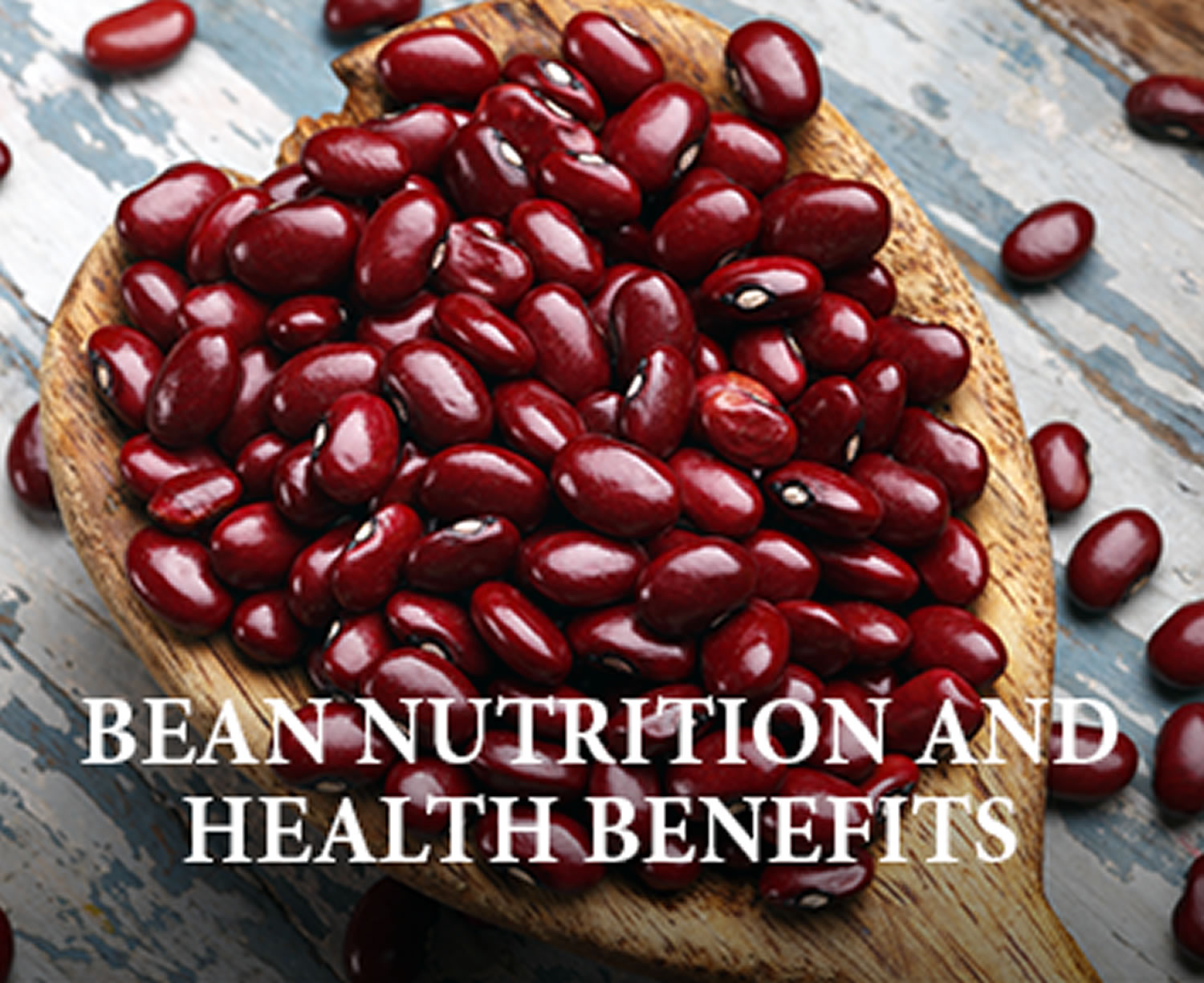
Beans & Health Overview
There is abundant research showing that regular bean consumption provides a variety of health benefits. Numerous studies indicate that frequently eating beans as a part of a healthful diet may reduce risk as well as aid in management of many chronic diseases.
- Beans & Weight Management
The interest and research in identifying foods that may help individuals maintain a healthy body weight is growing. As the global overweight and obesity epidemic continues, identifying foods that may aid in weight loss and weight management is extremely important.
Beans are a healthful, plant-based protein. They are naturally low in fat, high in fiber, and a good source of protein. Research shows that people who eat more fiber tend to weigh less, and protein has been shown to help people feel full longer. Consuming beans may contribute to feelings of fullness and satiety as a result of the beans’ fiber and protein content 23.
A number of studies have sought to determine the role of beans (and other pulses) and their contributions to maintaining a healthful weight and aiding in weight loss.
In a study of 35 obese men fed four different protein-rich diets, the diet providing the majority of protein from legumes (including beans) produced the greatest amount of weight loss in an eight-week period 24. Members of the group instructed to eat legumes at least four days a week also experienced significant reductions in waist circumference, body fat mass, blood pressure, and total cholesterol when compared with members of the other groups.
According to results from the National Health & Nutrition Examination Survey (NHANES), adults who consumed beans on a regular basis were less likely (−22%) to be classified as obese, have reduced systolic blood pressure, lower body weight and a higher waist circumference (−23%) than those who did not consume beans 25.
According to the results of studies conducted in Brazil, a traditional diet high in rice and beans was associated with a lower body mass index (BMI), compared with a typical Western diet containing more fat, snacks and soda 26, 27.
Researchers also have studied the role of hormones, including leptin and ghrelin, in regulating appetite and weight. Researchers measured the leptin and ghrelin levels in 36 insulin-sensitive and 28 insulin resistant men. Leptin levels decreased among the group consuming a diet enriched with legumes. When leptin is present in smaller concentrations, it is more effective in regulating appetite and may aid in weight loss and weight maintenance 28.
A randomized controlled trial looking at the effect of pulse consumption in combination with whole grains in obese adults found that participants who consumed 2 servings of pulses and 4 servings of whole grain foods per day, as substitutions for more refined carbohydrates, had higher intakes of fiber and a greater reduction in waist circumference (−2.8 cm after 18 months) than the control group 29. In addition, American bean consumers aged 12–19 years weighed significantly less than non-consumers and had smaller waist measurements when compared with their non-consuming counterparts 30.
Overall, research supports the regular consumption of beans as part of a healthy diet to promote weight control.
- Beans and Longevity
An individual’s diet has been shown to affect disease susceptibility and survival. Comparing the dietary patterns of older adults is one approach to discovering if there is a common denominator that promotes longevity. In a cross-cultural study looking at food intake patterns of adults 70 years and older, the only statistically significant consistent indicator of longevity was legume intake 31. For every 20 grams of legumes consumed each day, there was a 7-8% reduction in mortality (based on hazard ratios). A half-cup serving of beans weighs about 85 grams, so based on these findings you may reduce your risk of all-cause mortality by 30-34% if you consume a half-cup of beans most days.
- Beans and Diabetes
Diabetes is becoming more common around the world as the overweight and obesity epidemic continues. Eating a variety of legumes, including beans, may be valuable not only in the prevention but also management of diabetes.
Beans are rich in slowly digestible carbohydrates and fiber as well as protein, giving them a low glycemic index. This makes them an ideal food for the management of insulin resistance and diabetes. Beans also provide protein as well as important vitamins and minerals in the diet.
According to the American Diabetes Association, “The glycemic index (GI) is a ranking of carbohydrates on a scale from 0 to 100 according to the extent to which they raise blood sugar levels after eating. Foods with a high GI are those that are rapidly digested and absorbed and result in marked fluctuations in blood sugar levels. Low-GI foods, by virtue of their slow digestion and absorption, produce gradual rises in blood sugar and insulin levels, and have proven benefits for health.”
Numerous studies show that consuming a low glycemic load diet may be protective against developing diabetes, while consuming a high glycemic load diet may increase the risk. This makes beans an important food for individuals working to manage blood sugars.
The glycemic load of a food is calculated by taking the glycemic index and multiplying it by the amount of total carbohydrate in a portion of food. Pinto beans cooked from the dry form have a glycemic index of 39, meaning the pinto beans only increase a person’s blood sugar by 39% compared to glucose or white bread. A ½ cup portion of pinto beans contains 22 grams of total carbohydrate, so the glycemic load is approximately 9.
The American Diabetes Association suggests that people with diabetes include dry beans (like kidney or pinto beans) and lentils into meals. The USDA MyPlate also recommends beans as a healthy food choice. The 2015-2020 Dietary Guidelines for Americans recommends eating 3 cups of legumes (including beans) per week. That is equal to approximately ½ cup per day.
- Beans, glycemic index, and glycemic load
The study by Livesey 32 provides very strong evidence that eating diets with a low glycemic index (< 45), a low glycemic load (<100 g equivalents per day), and more than 25g per day of fiber will help normalize blood glucose, blood insulin, and body weight. Controlling blood glucose, blood insulin, and body weight in turn will reduce the risk of type 2 diabetes and cardiovascular disease, as well as certain types of cancer.
Beans are the perfect food to improve glycemic control. Beans have a low glycemic index, varying from 27-42% relative to glucose and 40-59% that of white bread (Table 2). Beans are also high in non-starch polysaccharides (typically 18-20%), 5% resistant starch, and 4% oligosaccharides to give a dietary fiber value of 27 – 29%. Consuming beans may significantly increase dietary fiber intake, and that is particularly important for blood sugar control.
| Table 2: Glycemic Indices of Various Beans 33 | ||
|---|---|---|
| GI (White Bread) | GI (Glucose) | |
| Pinto beans | 55 | 39 |
| Kidney beans | 42 | 27 |
| Baked beans, canned | 57 | 40 |
| Dried beans | 40 | 29 |
| Black-eyed peas | 59 | 42 |
| Butter beans | 44 | 31 |
| Chick peas | 47 | 33 |
| *Calculated glycemic index when white bread or glucose were used as a reference food. Expressed as a percentage of the reference food. | ||
- Beans and Heart Health
Beans promote heart health because of what they contain (fiber and potassium) as well as what they don’t contain (no saturated fat, trans fat, cholesterol, or sodium).
Elevated blood levels of triglycerides and cholesterol, especially LDL cholesterol, are significant contributing factors to the risk of heart disease. Legume and dry bean consumption have been shown to improve serum lipid profiles in patients with coronary heart disease and research shows that a healthful diet that includes beans may reduce the risk of heart disease.
Therapeutic Lifestyle Changes (TLC) is a program from the National Cholesterol Education Program (NCEP) to help lower cholesterol through lifestyle approaches (National Heart, Lung, and Blood Institute, 2005). As dietary changes are typically the first step in lowering cholesterol, the TLC diet is a great first approach to lower one’s cholesterol.
The TLC diet emphasizes fruits and vegetables, whole grains, lean meats and low-fat dairy. It recommends limiting consumption of saturated and trans fat, and fatty meats. It also includes recommendations for the use of functional foods such as legumes, oats, and margarines containing plant stanols/sterols to lower cholesterol.
The National Cholesterol Education Program Adult Treatment Panel III guidelines identify legumes as a good low saturated fat protein source and also recognize their contribution to viscous or soluble fiber intake in the diet 34. One-half cup of legumes supplies 5.5 – 8 grams of total fiber including 1 – 3.5 grams of viscous or soluble fiber or 10-35% of the 5 – 10 grams of daily viscous or soluble fiber intake recommended by the National Cholesterol Education Program Adult Treatment Panel III 34.
- Beans and Cancer
Research has revealed that a healthful diet including beans may reduce the risk of certain types of cancer. Beans are natural sources of antioxidants and phytochemicals; these compounds work in the body to decrease the risk of cancer, as well as other chronic diseases.
The World Cancer Research Fund/American Institute for Cancer Research 35 published a comprehensive review that linked diet to cancer at 19 different locations in the body. Considering the cause of cancer at many of the sites, one would expect that diet would have little impact except for excess body fat possibly increasing the risk. Beans were not considered a separate set, but part of a group of foods labeled “pulses (legumes)”. If a food, group of foods, and/or individual nutrient was found to be related to cancer incidence at one of the 19 sites, the relationship was classified as “decreased the risk” or “increased the risk”. The strength of the evidence was classified as “convincing”, “probable”, “limited – suggestive”, or “limited – no conclusion”. To be classified as “probable”, there had to be considerable data demonstrating a relationship existed.
The panel of experts did not feel that the evidence relating legume consumption to a decreased risk of developing cancer was “convincing” or “probable” for cancer located at any of the 19 sites in the body. However, fiber-containing foods were considered “probable” for reducing the risk of cancer in the colon and rectum. Since beans are rich in fiber, it can be inferred that eating beans will probably reduce one’s risk of developing colon and rectal cancer. The data relating legume consumption to a reduction of stomach and prostate cancer was considered “limited, but suggestive”. The link between stomach cancer and legume intake is most likely based on soy and not on legumes other than soy. The study panel concluded that the data suggest that eating non-soy legumes would result in a reduction in prostate cancer. The panel also felt that the data relating foods rich in folate (naturally occurring or fortified) to a reduction in colon and rectal cancer was suggestive, but limited. The data relating legume consumption to cancers of the mouth, pharynx, larynx, esophagus, lung, pancreas, breast, ovary, and endometrium was too limited and no conclusion could be reached.
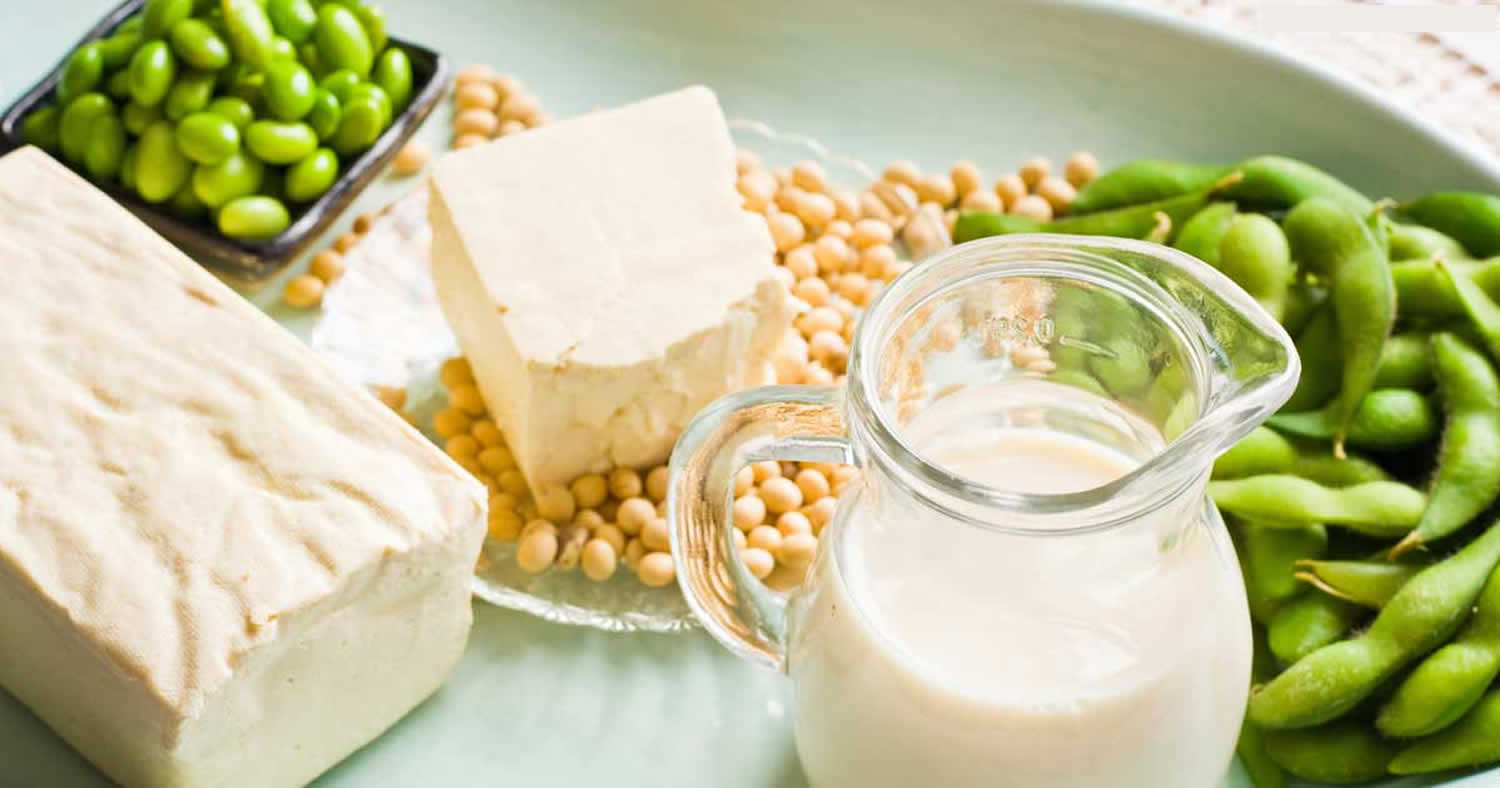
Soy Bean
Is soy a legume ? Yes 14.
Soy, a plant in the pea family, has been common in Asian diets for thousands of years. It is found in modern American diets as a food or food additive 36. Soybeans, the high-protein seeds of the soy plant, contain isoflavones—compounds similar to the female hormone estrogen (phytoestrogens). Isoflavones are often referred to as phytoestrogens or plant-based estrogens because they have been shown, in cell line and animal studies, to have the ability to bind with the estrogen receptor 37. Research alos suggests that daily intake of soy protein may slightly lower levels of LDL (“bad”) cholesterol. Soy products are used for menopausal symptoms, bone health, improving memory, high blood pressure, and high cholesterol levels 36. In addition to its food uses, soy is available in dietary supplements, in forms such as tablets, capsules, and powders. Soy supplements may contain soy protein, isoflavones (compounds that have effects in the body similar to those of the female hormone estrogen), or other soy components 36.
Soy protein is a high quality protein that has been extensively studied. Soy provides a complete source of dietary protein, meaning that, unlike most plant proteins, it contains all the essential amino acids 38. The quality of soy protein has been assessed through several metabolic studies of nitrogen balance 39, 40, 41, which have demonstrated that soy protein supports nitrogen balance on par with beef and milk proteins. One recent study reported that amino acids from soy protein appear in the serum sooner, but that this may lead to a more rapid breakdown of the amino acids in the liver 42. Americans as a whole still consume very little soy protein. Based on 2003 data from the UN Food and Agriculture Organization, per-capita soy protein consumption is less than 1 gram (g) per day in most European and North American countries, although certain subpopulations such as vegetarians, Asian immigrants, and infants fed soy-based formula consume more. The Japanese, on the other hand, consume an average 8.7 g of soy protein per day; Koreans, 6.2–9.6 g; Indonesians, 7.4 g; and the Chinese, 3.4 g 38.
Traditional soy foods include tofu, which is produced by puréeing cooked soybeans and precipitating the solids, and miso and tempeh, which are made by fermenting soybeans with grains. “Second generation” soy products involve chemical extractions and other processing, and include soy protein isolate and soy flour. These products become primary ingredients in items such as meatless burgers, dietary protein supplements, and infant formula, and are also used as nonnutritive additives to improve the characteristics of processed foods 38.
Table 3. Soy (Soya or Edamame) Bean Nutrition Content
Nutrient | Unit | cup 80 g | Value per 100 g | ||||||||||||||||
|---|---|---|---|---|---|---|---|---|---|---|---|---|---|---|---|---|---|---|---|
| Approximates | |||||||||||||||||||
| Energy | kcal | 120 | 150 | ||||||||||||||||
| Protein | g | 8.50 | 10.62 | ||||||||||||||||
| Total lipid (fat) | g | 3.80 | 4.75 | ||||||||||||||||
| Carbohydrate, by difference | g | 11.00 | 13.75 | ||||||||||||||||
| Fiber, total dietary | g | 2.8 | 3.5 | ||||||||||||||||
| Sugars, total | g | 1.90 | 2.38 | ||||||||||||||||
| Minerals | |||||||||||||||||||
| Calcium, Ca | mg | 80 | 100 | ||||||||||||||||
| Iron, Fe | mg | 1.80 | 2.25 | ||||||||||||||||
| Sodium, Na | mg | 311 | 389 | ||||||||||||||||
| Vitamins | |||||||||||||||||||
| Vitamin C, total ascorbic acid | mg | 1.2 | 1.5 | ||||||||||||||||
| Vitamin A, IU | IU | 400 | 500 | ||||||||||||||||
| Lipids | |||||||||||||||||||
| Fatty acids, total saturated | g | 0.496 | 0.620 | ||||||||||||||||
| Fatty acids, total trans | g | 0.000 | 0.000 | ||||||||||||||||
| Cholesterol | mg | 0 | 0 | ||||||||||||||||
Soy-Based Infant Formula
At present there is no definitive evidence that phytoestrogens have toxic effects in human infants who are fed a diet of soy formula, concern has been raised from research carried out in vitro and in animal studies 44. The present practice point seeks to provide an overview of phytoestrogens and soy formulas. More detailed information on phytoestrogens and human health is available through several excellent expert panel reviews, Food Standards Agency, Department of Health – United Kingdom 45 and NTP-CERHR expert panel report on the reproductive and developmental toxicity of soy formula 46 on the subject.
Some of the confusion in interpreting the literature on soy is the varied forms in which this product can be consumed. It ranges from whole soy foods evaluated in epidemiological studies to components of soy, such as soy concentrates, soy isolates, isolated isoflavone mixtures, supplements or pure isoflavones 47.
Approximately 20–25% of U.S. infants receive at least some soy-based formula in their first year (there are no numbers on how many are exclusively fed soy formula). Unlike soy milk, which is sometimes mistakenly—and tragically—used in its place, soy formula contains soy protein isolate supplemented with additional amino acids, minerals, vitamins, and fats necessary to support infant growth and development. Parents may choose soy formula for babies who are allergic to cow’s milk–based formula or if they themselves do not consume dairy products 38.
Phytoestrogens are plant-derived substances with estrogenic activity. Soy-based infant formulas contain phytoestrogens of the isoflavone class, which includes genistein, daidzein and glycitein. These isoflavones are relatively weak estrogens, with approximately 1/1000 to 1/10,000 of the potency of estradiol in the rodent uterotrophic assay – the ‘gold standard’ for determining estrogenic activity in experimental animals 48, 49. However, they are present in relatively large amounts in soy-based formulas, such that the total isoflavone content is approximately 40 μg/mL in ready-to-use soy formulas 44. Infants who consume these products have isoflavone plasma concentrations of approximately 13,000 to 22,000 times greater than their estradiol plasma concentrations. In contrast, the plasma concentrations of isoflavones in infants who are fed cow’s milk formula or breast milk are only 50 to 200 times greater than their estradiol plasma concentrations 50. There is concern that these isoflavones may mimic the actions of estradiol or alter estradiol metabolism, and consequently modify the processes influenced by estradiol. Despite this theoretical possibility, practical experience has shown that the millions of infants who have consumed these products since the 1960s appear to have grown and matured normally.
The daily intake of phytoestrogens by infants consuming soy-based formula ranges from 4 mg/kg to 11 mg/kg body weight 50. This dose is greater than the daily intake of approximately 1 mg/kg body weight of an adult consuming a traditional Japanese diet or a person consuming a modest amount of soy products 51. Over 94% of the phytoestrogens in soy-based infant formulas are present in a biologically inactive form, primarily as beta-glycosylated isoflavones 50. Once ingested, phytoestrogens are activated by the removal of glycoside by bacteria in the intestinal tract – a process necessary for absorption 52. Data from animal studies 53 suggest that phytoestrogens may be transformed into an inactive glucuronidated form during the absorption process, or once absorbed, they may be inactivated by the liver through the formation of glucuronidated or sulfated isoflavones. Whichever the case, clinical data show that 0% to 3% of the phytoestrogens present in the plasma of infants who consume soy-based formula are in the biologically active form 54. Infants that are fed soy-based formulas do not accumulate phytoestrogens in their plasma 55.
Although no overt toxicity is associated with the consumption of soy-based infant formula in healthy infants 56, a recent clinical study 57 has reported the development of abnormal thyroid function from the ingestion of soy-based formula in infants with congenital hypothyroidism. Data from animal studies 58 suggest that phytoestrogens can inhibit thyroid peroxidase, potentially lowering free thyroxine concentrations, which could lead to abnormal thyroid function. Therefore, infants with congenital hypothyroidism who are fed soy-based infant formulas should have their thyroxine levels monitored. This does not appear to be a problem in infants with healthy thyroid function.
In a study on gender-role play behavior in relation to soy-based and non-soy-based infant feeding methods among children in the Avon Longitudinal Study of Parents and Children 59 involving 3,664 boys and 3,412 girls, with 2% having early-infancy soy use. The authors concluded that although not consistent throughout childhood, early-life soy exposure was associated with less female-typical play behavior in girls at 42 months of age. Soy exposure was not significantly associated with play behavior in boys 59.
A recent retrospective human study 60 showed that adults who consumed soy-based formulas as infants were not different from adults who had been fed cow’s milk-based formulas with respect to reproductive maturity, cancer development and general health. No statistically significant differences were found between the two adult male groups. Women fed soy-based formulas as infants had a slightly greater incidence of regularly using asthma and allergy medications than the group who were fed cow’s milk formulas. Also, women who were fed soy-based infant formulas had a slightly longer duration of menstrual bleeding (0.37 days) and experienced more discomfort during their menstruation than the group who were fed cow’s milk formulas. The authors of the study did not consider these findings to be biologically significant, but others had concerns about the potential implications of these findings 61.
Currently available soy-based formulas support normal growth and nutritional status for the first year of life, with no overt toxicities observed in normal infants 46, 62, 63, 64, 65, 66, 67. However, soy-based infant formulas may not adequately promote growth in premature infants, and its use in this population is not recommended 68, 69. Long-term safety data are very limited, but no significant toxicities have been reported 70. In addition to these studies, over 40 years of use support the safety of currently available formulations (39). The Committee on Toxicity (United Kingdom) released a report in 2003 titled “Phytoestrogens and Health” 45, which identified infants who were fed soy-based formulas as the population subgroup with exposure to the highest concentrations of isoflavones. Although this committee did not identify definitive evidence of adverse health effects in their review, they believed that the potential risks were a concern. The Committee on Toxicity also sought consultation with the United Kingdom’s Scientific Advisory Committee on Nutrition, who suggested that there was no substantive medical need for, nor health benefit arising from, the use of soy-based infant formulas.
Cow’s milk protein allergy
Cow’s milk protein allergy is the most common food allergy experienced by infants. Prospective studies 71, 72, 73, 74 have demonstrated a Cow’s milk protein allergy incidence of approximately 2.5% among infants younger than one year of age. However, making a definitive diagnosis of cow’s milk protein allergy can be difficult.
Some of the limitations to the studies on cow’s milk protein allergy have been the lack of uniformity in what is labelled or diagnosed as cow’s milk protein allergy, and the failure to distinguish between IgE- and non-IgE-mediated cow’s milk protein allergy 44. This classification is a simplified version and does not represent a true breakdown of the various classifications of hypersensitivity reactions 44. In part, this has led to some apparently contradictory or unclear recommendations for the treatment of cow’s milk protein allergy. Symptoms and signs alone have been used to make the diagnosis, but these lack appropriate sensitivity and specificity for distinguishing between IgE- and non-IgE-mediated cow’s milk protein allergy. Traditionally an IgE-mediated cow’s milk protein allergy would present with urticaria, angioedema, respiratory and gastrointestinal features 44. In contrast, non-IgE-mediated cow’s milk protein allergy presents with significant gastrointestinal manifestations, most frequently with blood in the stool 44. However, the boundary between the symptoms and signs of IgE- and non-IgE-mediated cow’s milk protein allergy is not distinct. Skin prick testing or detection of either specific or nonspecific IgE antibodies can be helpful in the diagnosis of IgE-mediated allergies if they are positive 75.
A number of paediatric societies have published recommendations on the use of soy-based formula in children, frequently with discussions of its role in the management of cow’s milk protein allergy. With respect to its use in cow’s milk protein allergy, the use of soy-based formulas is only contraindicated for nonimmunoglobulin E (IgE)-mediated cow’s milk protein allergy 76. This contraindication stems from the high rate of coincident soy allergies in these patients 44.
Both the American Academy of Pediatrics and the European Society for Paediatric Gastroenterology Hepatology and Nutrition Committee on Nutrition recently produced papers on soy protein infant formulas 69, 77. They recommend extensively hydrolyzed protein (or amino acid-based formulas if hydrolyzed formulas not tolerated) for the treatment of infants with cow’s milk protein allergy. The ESPGHAN Committee on Nutrition also specified that especially for infants younger than six months of age, soy-based formulas should not be used to treat cow’s milk protein allergy given the higher reported rate of adverse reactions to soy protein in the population 69. Therefore, the safer route is to recommend the use of extensively hydrolyzed infant formula when a diagnosis of cow’s milk protein allergy is made, with the caveat that if non-IgE-mediated cow’s milk protein allergy can be satisfactorily ruled out, then the use of soy formula is not contraindicated 44.
Health Effects of Soy
Soybeans and soy foods contain a variety of bioactive components, including saponins, protease inhibitors, phytic acid, and isoflavones. Isoflavones belong to a class of compounds generally known as phytoestrogens, plant compounds that have estrogen-like structures. The dominant isoflavone in soy is genistein, with daidzein and glycitein composing the remainder. Within soy, isoflavones are almost entirely bound to sugars, producing the respective compounds genistin, daidzin, and glycitin. Soy isoflavones have been linked with numerous health effects, but the strength of the relationships and whether the effects are beneficial are strongly debated 38.
Soy has been a dietary supplement of interest for decreasing menopausal symptoms and breast cancer for some time. The interest comes primarily from association studies of a high-soy diet and decreased breast cancer/menopausal symptoms in Asia. Soy is an isoflavone, which is part of a much larger class of plant compounds called flavonoids. Three types of isoflavones are found in soy products:
- Genistein
- Daidzein
- Glycitein
Isoflavones are often referred to as phytoestrogens or plant-based estrogens because they have been shown, in cell line and animal studies, to have the ability to bind with the estrogen receptor.
There is confusion about the safety of these plant-based estrogens because these agents can have properties that can cause estrogen-like effects in some cells, causing them to proliferate (divide and grow); while in other cells, isoflavones can stop or block estrogen effects, causing unwanted cells to not grow or even die 78. There is continuing debate about the following questions:
- What doses and types of soy inhibit estrogen as a growth factor ?
- Under what circumstances does soy inhibit estrogen as a growth factor ?
- In what doses or circumstances does soy promote estrogen-related growth ?
Definitive answers to these questions are not known, but phytoestrogens continue to be investigated for chemopreventive properties 79. On the other hand, soy has been well studied in numerous randomized, placebo-controlled trials for its effects on reducing hot flashes. Most of those trials show that soy is no better than a placebo in reducing hot flashes 80, 81, 82, 83, 84, 85. Currently, there are no compelling data that would inspire the use of soy for hot flash management 86.
Similarly, trials of black cohosh (a perennial herb is used to treat the symptoms of menopause) that have been well designed with a randomized, placebo-controlled arm have also found that black cohosh is no better than a placebo in reducing hot flashes 84, 87, 88. Black cohosh used to be thought of as having estrogenic properties, but it is now known that it acts on serotonin receptors. One study evaluated black cohosh, red clover, estrogen and progesterone, and placebo in a randomized, double-blind trial 89. Each treatment arm was small (n = 22); however, over 12 months, hot flashes were reduced 34% by black cohosh, 57% by red clover, 63% by placebo, and 94% by hormone therapy. Of note, adherence rates were reported to be about 89% over the four groups during this long-term study. At 12 months, physiologic markers such as endometrial thickness, estradiol, estrone, follicle-stimulating hormone, sex hormone–binding globulin, and liver function tests were not statistically different for those on either red clover or black cohosh, compared with those on placebo. However, because these groups were small, the power for this secondary analysis was not reported, and it was likely underpowered to detect important differences 90.
Soy research is complicated because there’s considerable variation in isoflavone exposure among people classified as soy consumers. Agronomic factors (such as the soybean cultivar and the environmental conditions under which the crop grew) affect a food’s isoflavone profile, as does the way a soy food is processed. For example, soy protein concentrate produced by alcohol extraction may have only 12.5 milligrams (mg) total isoflavones per 100 g, in contrast to the nearly 199.0 mg total isoflavones per 100 g of full-fat roasted soy flour. Additionally, the fact that most of the isoflavones in food occur bound to sugar affects how they are digested 38.
Soy isoflavones are frequently referred to as weak estrogens, and depending upon the specific circumstance, they can act as agonists, partial agonists, or antagonists to endogenous estrogens (such as estradiol) and xenoestrogens (including phytoestrogens) at estrogen receptors. They are not especially potent, however, and activity varies by tissue concentration, cell type, hormone receptor type, and stage of differentiation 38. In addition to their estrogen receptor activity, isoflavones may also interfere with steroid metabolism by inhibiting aromatase, hydroxysteroid dehydrogenase, and steroid α-reductase, and by altering the ratio of estradiol metabolites. Soy isoflavones may also act as antioxidants; inhibitors of proteases, tyrosine kinases, and topoisomerases; inducers of Phase I and/or Phase II enzymes such as cytochrome P450s, glutathione S-transferase, and quinone reductase; and inhibitors of angiogenesis 38.
Retha R. Newbold, a supervisory research biologist at the National Institute of Environmental Health Sciences, is concern about genistein’s effects on reproduction and development, because her studies, as well as others, have shown that genistein has such effects as inducing uterine adenocarcinoma in mice and premature puberty in rats. A recent study led by biologist Wendy Jefferson in Newbold’s laboratory and published in the October 2005 issue of Biology of Reproduction linked genistein with effects such as abnormal estrous cycle, altered ovarian function, and infertility in mice 38.
Considerably less attention has attached to daidzein, though there are currently indicators that it may play a larger role than genistein in soy’s apparent beneficial health effects. Like genistein, daidzein in soy exists primarily in linkage with a sugar molecule. Daidzein may be converted to equol (suspected of having a higher estrogenic potency than the original daidzein) by gastrointestinal bacteria. There is considerable variability in individuals’ ability to produce equol, and the metabolic pathways for both genistein and daidzein may vary due to factors such as a person’s particular microflora, intestinal transit time, and current or recent use of antibiotics and other drugs 38.
There have been only a few studies that have looked exclusively at glycitein, the third soy isoflavone, but those have not been on health effects. There are indicators from a couple of recent in vitro studies that glycitein may be protective of bone. Most glycitein research has focused on determining how to detect the compound, and its estrogenicity and metabolism 38.
- Isoflavone-Rich Soy Protein on Cognition in Postmenopausal Women
Soy protein supplements containing isoflavones, in an amount within the upper range of traditional Asian diets, had no effect on global cognition in postmenopausal women, according to a recent study published in the journal Neurology 91. However, this randomized, double-blind controlled trial indicated that soy protein supplements may improve visual memory (memory for faces) 91.
- Soy Protein, Isoflavones on LDL Cholesterol and Other Lipoproteins and Cardiovascular Health
Earlier research indicating that soy protein, as compared with other proteins, has clinically important favorable effects on LDL cholesterol and other CVD risk factors has not been confirmed by many studies reported during the past 10 years. The American Heart Association Science Advisory assesses the more recent work published on soy protein and its component isoflavones. In the majority of 22 randomized trials, isolated soy protein with isoflavones, as compared with milk or other proteins, decreased LDL cholesterol concentrations; the average effect was <3%. This reduction is very small relative to the large amount of soy protein tested in these studies, averaging 50 g, about half the usual total daily protein intake. No significant effects on HDL cholesterol, triglycerides, lipoprotein(a), or blood pressure were evident 92 .
A very large amount of soy protein, more than half the daily protein intake, may lower LDL cholesterol by a few percentage points when it replaces dairy protein or a mixture of animal proteins. The evidence favors soy protein rather than soy isoflavones as the responsible nutrient. However, at this time, the possibility cannot be ruled out that another component in soybeans could be the active factor. No benefit is evident on HDL cholesterol, triglycerides, lipoprotein(a), or blood pressure. Thus, the direct cardiovascular health benefit of soy protein or isoflavone supplements is minimal at best 92. Soy protein or isoflavones have not been shown to improve vasomotor symptoms of menopause, and results are mixed with regard to the slowing of postmenopausal bone loss. The efficacy and safety of soy isoflavones for preventing or treating cancer of the breast, endometrium, and prostate are not established 92; evidence from clinical trials is meager and cautionary with regard to a possible adverse effect. For this reason, use of isoflavone supplements in food or pills is not recommended 92. In contrast, soy products such as tofu, soy butter, soy nuts, or some soy burgers should be beneficial to cardiovascular and overall health because of their high content of polyunsaturated fats, fiber, vitamins, and minerals and low content of saturated fat 93. Using these and other soy foods to replace foods high in animal protein that contain saturated fat and cholesterol may confer benefits to cardiovascular health 94. Soy protein also may be used to increase total dietary protein intake and to reduce carbohydrate or fat intake. However, much less is known about the potential impact of high-protein diets on risk factors for cardiovascular disease. In the meantime, these remain dynamic areas for research.
The results of the current study demonstrate that soy food products generally have low GI values and low to medium GL values. Improvements in ingredient selection and usage may further improve glycemic responses to soy foods. The low GI of soy foods appears to be an additional benefit of soy for human health and suggests that soy foods are an appropriate part of diet plans intended to improve control over blood glucose and insulin levels 95.
What we know about Soy 96, 36
- Consuming soy protein in place of other proteins may lower levels of LDL (“bad”) cholesterol to a small extent 97, 98.
- Soy isoflavone supplements may help to reduce the frequency and severity of menopausal hot flashes, but the effect may be small 99, 100.
- It’s uncertain whether soy supplements can relieve cognitive problems associated with menopause 101.
- Current evidence suggests that soy isoflavone mixtures do not slow bone loss in Western women during or after menopause 102.
- Diets containing soy protein may slightly reduce blood pressure 103.
- There’s not enough scientific evidence to determine whether soy supplements are effective for any other health uses.
- Current National Center for Complementary and Integrative Health-funded studies on soy and its components are investigating a variety of topics, including stroke outcomes, anti-inflammatory effects, and effects on diabetes.
Summary: Although there have been many studies on soy products, there are still uncertainties about soy’s health effects. Except for people with soy allergies, soy is believed to be safe when consumed in normal dietary amounts. However, the safety of long-term use of high doses of soy extracts has not been established.
The most common side effects of soy are digestive upsets, such as stomach pain and diarrhea. Long-term use of soy isoflavone supplements might increase the risk of endometrial hyperplasia (a thickening of the lining of the uterus that may lead to cancer) 36. Soy foods do not appear to increase the risk of endometrial hyperplasia. Current evidence indicates that it’s safe for women who have had breast cancer or who are at risk for breast cancer to eat soy foods. However, it’s uncertain whether soy isoflavone supplements are safe for these women 36.
Peanuts
Is peanut a legume ? Yes 14. Peanuts are legumes, not nuts, because they grow in bushes.
The humble peanut—while technically a legume—appears to do just fine in helping to prevent heart disease and in extending life as almonds, walnuts, and other pricier tree nuts. Researchers at Vanderbilt University and the Shanghai Cancer Institute examined nut and peanut intake and mortality in three separate groups (participants included more than 70,000 Americans of African and European descent from the Southern Community Cohort Study, who were mostly low-income and more than 130,000 Chinese from the Shanghai Women’s Health Study and the Shanghai Men’s Health Study) over an average of six years and found lower rates of death, especially from heart disease 104. Peanut consumption was associated with a 17 percent to 21 percent reduction in deaths and a 23 percent to 38 percent decrease in cardiovascular death, across all three racial and ethnic groups, among both genders and among people with low socioeconomic status. The latest cohort study showed benefits from nut intake for people who ate 2/3 ounce, or about 18 grams, of peanuts a day, on average. That’s about a handful, with about 28 peanuts per ounce 104.
Currently, there are no treatments available for people with peanut allergy. According to researchers at Duke University Medical Center and Massachusetts General Hospital 105, a new treatment involving peanut sublingual immunotherapy may be a safe and effective form of immunotherapy for children with peanut allergy. The researchers found that the participants who had received peanut sublingual immunotherapy could safely consume 20 times more peanut protein than those who had received the placebo (1710 mg vs. 85 mg). This level of desensitization is clinically significant because it represents protection from accidental ingestion of peanut, which is often less than 100 mg (or one peanut). In addition, allergy skin prick tests showed a decreased allergic response to peanut in the treatment group. The blood tests showed immunologic changes in the treatment group, suggesting a significant change in allergic response 105.
Table 4. Peanut (Raw) Nutrition Content
Nutrient | Unit | Value per 100 g | oz 28.35 g | cup 146 g | |||||||||||||||
|---|---|---|---|---|---|---|---|---|---|---|---|---|---|---|---|---|---|---|---|
| Approximates | |||||||||||||||||||
| Water | g | 6.50 | 1.84 | 9.49 | |||||||||||||||
| Energy | kcal | 567 | 161 | 828 | |||||||||||||||
| Protein | g | 25.80 | 7.31 | 37.67 | |||||||||||||||
| Total lipid (fat) | g | 49.24 | 13.96 | 71.89 | |||||||||||||||
| Carbohydrate, by difference | g | 16.13 | 4.57 | 23.55 | |||||||||||||||
| Fiber, total dietary | g | 8.5 | 2.4 | 12.4 | |||||||||||||||
| Sugars, total | g | 4.72 | 1.34 | 6.89 | |||||||||||||||
| Minerals | |||||||||||||||||||
| Calcium, Ca | mg | 92 | 26 | 134 | |||||||||||||||
| Iron, Fe | mg | 4.58 | 1.30 | 6.69 | |||||||||||||||
| Magnesium, Mg | mg | 168 | 48 | 245 | |||||||||||||||
| Phosphorus, P | mg | 376 | 107 | 549 | |||||||||||||||
| Potassium, K | mg | 705 | 200 | 1029 | |||||||||||||||
| Sodium, Na | mg | 18 | 5 | 26 | |||||||||||||||
| Zinc, Zn | mg | 3.27 | 0.93 | 4.77 | |||||||||||||||
| Vitamins | |||||||||||||||||||
| Vitamin C, total ascorbic acid | mg | 0.0 | 0.0 | 0.0 | |||||||||||||||
| Thiamin | mg | 0.640 | 0.181 | 0.934 | |||||||||||||||
| Riboflavin | mg | 0.135 | 0.038 | 0.197 | |||||||||||||||
| Niacin | mg | 12.066 | 3.421 | 17.616 | |||||||||||||||
| Vitamin B-6 | mg | 0.348 | 0.099 | 0.508 | |||||||||||||||
| Folate, DFE | µg | 240 | 68 | 350 | |||||||||||||||
| Vitamin B-12 | µg | 0.00 | 0.00 | 0.00 | |||||||||||||||
| Vitamin A, RAE | µg | 0 | 0 | 0 | |||||||||||||||
| Vitamin A, IU | IU | 0 | 0 | 0 | |||||||||||||||
| Vitamin E (alpha-tocopherol) | mg | 8.33 | 2.36 | 12.16 | |||||||||||||||
| Vitamin D (D2 + D3) | µg | 0.0 | 0.0 | 0.0 | |||||||||||||||
| Vitamin D | IU | 0 | 0 | 0 | |||||||||||||||
| Vitamin K (phylloquinone) | µg | 0.0 | 0.0 | 0.0 | |||||||||||||||
| Lipids | |||||||||||||||||||
| Fatty acids, total saturated | g | 6.279 | 1.780 | 9.167 | |||||||||||||||
| Fatty acids, total monounsaturated | g | 24.426 | 6.925 | 35.662 | |||||||||||||||
| Fatty acids, total polyunsaturated | g | 15.558 | 4.411 | 22.715 | |||||||||||||||
| Fatty acids, total trans | g | 0.000 | 0.000 | 0.000 | |||||||||||||||
| Cholesterol | mg | 0 | 0 | 0 | |||||||||||||||
| Other | |||||||||||||||||||
| Caffeine | mg | 0 | 0 | 0 | |||||||||||||||
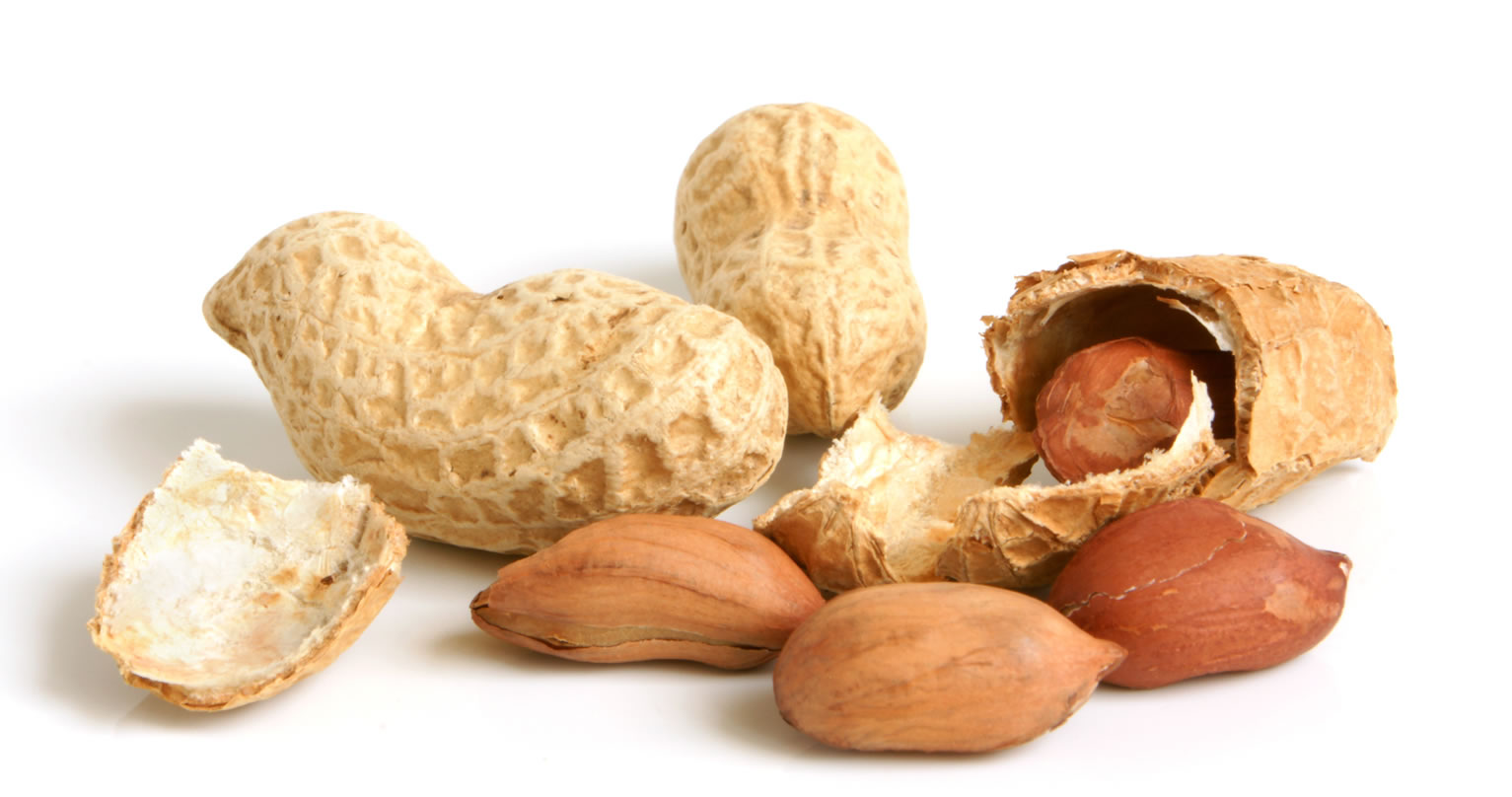
Peas (Pisum sativum)
Are peas a legume ? Yes 14.
Green peas have been largely overlooked in research studies on legumes, which have tended to concentrate only on beans.
Green peas are loaded with antioxidants and anti-inflammatory nutrients, and these health-supportive nutrients are provided in a wide range of nutrient categories. For example, in the flavonoid category, green peas provide us with the antioxidants catechin and epicatechin. In the carotenoid category, they offer alpha-carotene and beta-carotene. Their phenolic acids include ferulic and caffeic acid. Their polyphenols include coumestrol. Pisumsaponins I and II and pisomosides A and B are anti-inflammatory phytonutrients found almost exclusively in peas. Antioxidant vitamins provided by green peas include vitamin C and vitamin E, and a good amount of the antioxidant mineral zinc is also found in this amazing food. Yet another key anti-inflammatory nutrient needs to be added to this list, and that nutrient is omega-3 fat. Recent research has shown that green peas are a reliable source of omega-3 fat in the form of alpha-linolenic acid (ALA). In one cup of green peas, you can expect to find about 30 milligrams of ALA.
Table 5. Peas (Green Raw) Nutrition Content
Nutrient | Unit | Value per 100 g | cup 145 g | ||||||||||||||||
|---|---|---|---|---|---|---|---|---|---|---|---|---|---|---|---|---|---|---|---|
| Approximates | |||||||||||||||||||
| Water | g | 78.86 | 114.35 | ||||||||||||||||
| Energy | kcal | 81 | 117 | ||||||||||||||||
| Protein | g | 5.42 | 7.86 | ||||||||||||||||
| Total lipid (fat) | g | 0.40 | 0.58 | ||||||||||||||||
| Carbohydrate, by difference | g | 14.45 | 20.95 | ||||||||||||||||
| Fiber, total dietary | g | 5.7 | 8.3 | ||||||||||||||||
| Sugars, total | g | 5.67 | 8.22 | ||||||||||||||||
| Minerals | |||||||||||||||||||
| Calcium, Ca | mg | 25 | 36 | ||||||||||||||||
| Iron, Fe | mg | 1.47 | 2.13 | ||||||||||||||||
| Magnesium, Mg | mg | 33 | 48 | ||||||||||||||||
| Phosphorus, P | mg | 108 | 157 | ||||||||||||||||
| Potassium, K | mg | 244 | 354 | ||||||||||||||||
| Sodium, Na | mg | 5 | 7 | ||||||||||||||||
| Zinc, Zn | mg | 1.24 | 1.80 | ||||||||||||||||
| Vitamins | |||||||||||||||||||
| Vitamin C, total ascorbic acid | mg | 40.0 | 58.0 | ||||||||||||||||
| Thiamin | mg | 0.266 | 0.386 | ||||||||||||||||
| Riboflavin | mg | 0.132 | 0.191 | ||||||||||||||||
| Niacin | mg | 2.090 | 3.030 | ||||||||||||||||
| Vitamin B-6 | mg | 0.169 | 0.245 | ||||||||||||||||
| Folate, DFE | µg | 65 | 94 | ||||||||||||||||
| Vitamin B-12 | µg | 0.00 | 0.00 | ||||||||||||||||
| Vitamin A, RAE | µg | 38 | 55 | ||||||||||||||||
| Vitamin A, IU | IU | 765 | 1109 | ||||||||||||||||
| Vitamin E (alpha-tocopherol) | mg | 0.13 | 0.19 | ||||||||||||||||
| Vitamin D (D2 + D3) | µg | 0.0 | 0.0 | ||||||||||||||||
| Vitamin D | IU | 0 | 0 | ||||||||||||||||
| Vitamin K (phylloquinone) | µg | 24.8 | 36.0 | ||||||||||||||||
| Lipids | |||||||||||||||||||
| Fatty acids, total saturated | g | 0.071 | 0.103 | ||||||||||||||||
| Fatty acids, total monounsaturated | g | 0.035 | 0.051 | ||||||||||||||||
| Fatty acids, total polyunsaturated | g | 0.187 | 0.271 | ||||||||||||||||
| Fatty acids, total trans | g | 0.000 | 0.000 | ||||||||||||||||
| Cholesterol | mg | 0 | 0 | ||||||||||||||||
| Other | |||||||||||||||||||
| Caffeine | mg | 0 | 0 | ||||||||||||||||
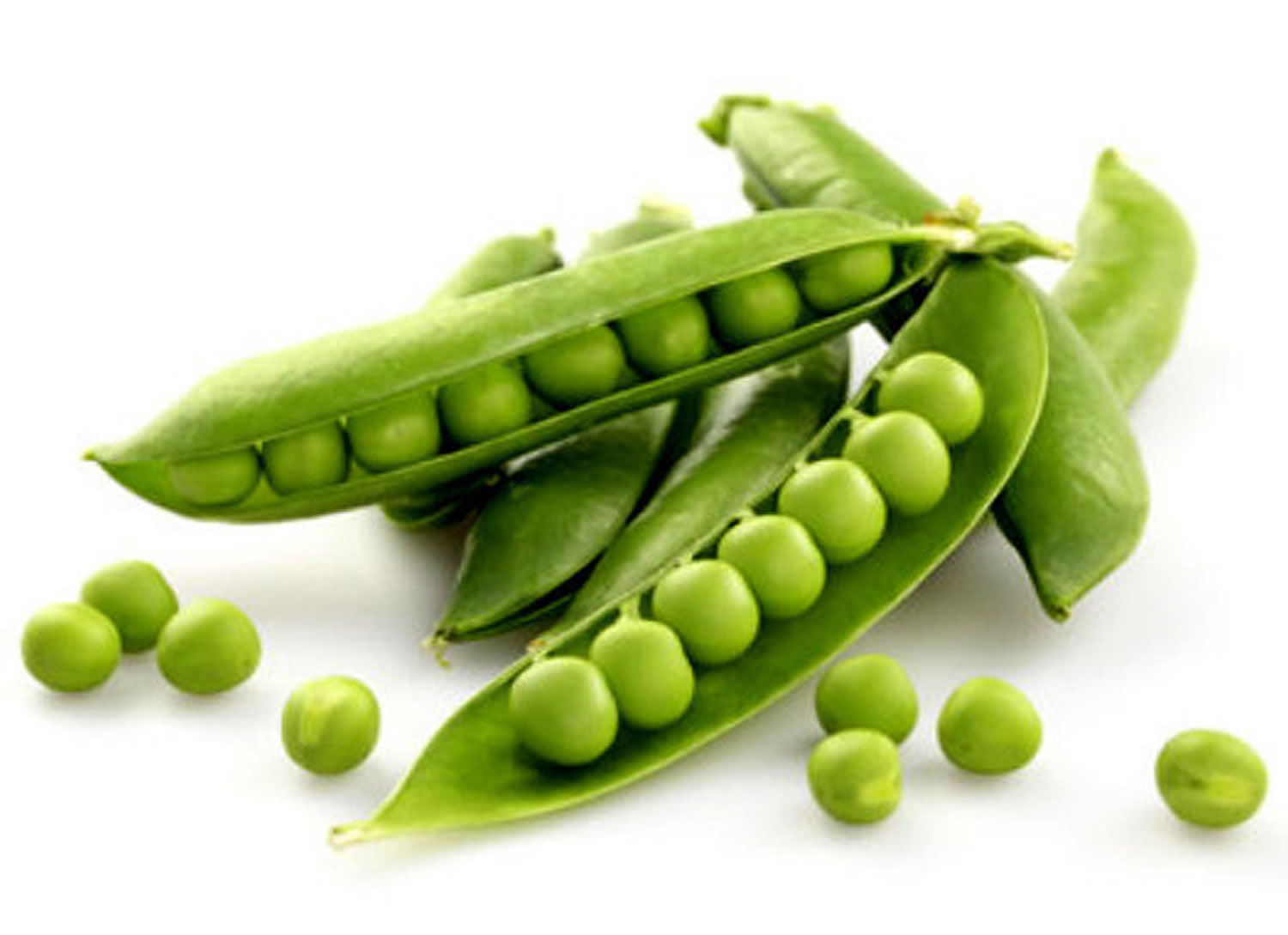
- United States Department of Agriculture National Nutrient Database for Standard Reference. https://ndb.nal.usda.gov/ndb/[↩]
- Topping, D. L., and Clifton, P. M., Short-Chain Fatty Acids and Human Colonic Function: Roles of Resistant Starch and Non-starch Polysaccharides. Physiol. Rev. 2001; 81(3): 1031-1064.[↩]
- Behall, K. M., and Howe, J. C., Contribution of Fiber and Resistant Starch to Metabolizable Energy. Am. J. Clin. Nutr. 1995; 62: 1158S-1160S.[↩]
- Raban, A., et al. Resistant Starch: The Effect on Postprandial Glycemia, Hormonal Response, and Satiety. Am. J. Clin. Nutr. 1994; 60: 544-551.[↩]
- Englyst, H. N., Kingman, S. M., and Cummings, J. H., Classification and Measurement of Nutritionally Important Starch Fractions. Eur. J. Clin. Nutr. 1992; 46: 533-550.[↩]
- Crosby, G. A., Resistant Starch Makes Better Carbs. Functional Foods and Nutraceuticals, 2003; 6: 34-36.[↩][↩]
- Thompson, D. B. Strategies for the Manufacture of Resistant Starch. Trends Food Sci. Tech. 2000; 11(7): 245-253.[↩][↩]
- Perea, A., Meda, V., and Tyler, R. T. Resistant Starch: A Review of Analytical Protocols for Determining Resistant Starch Content of Foods. Food Res. Intern. 2010; 43: 1959-1974.[↩]
- Fabbri, A. D. T., Schacht, R. W., and Crosby, G. A. Evaluation of Resistant Starch Content of Cooked Black Beans, Pinto Beans and Chickpeas. NFS Journal 3. 2016; 8-12.[↩][↩]
- Bednar, G. E., et al. Starch and Fiber Fractions in Selected Food and Feed Ingredients Affect Their Small Intestinal Digestibility and Fermentability and Their Large Bowel Fermentability in Vitro in a Canine Model. J. Nutr. 2001; 131: 276-286.[↩]
- Noah, L. et al. Digestion of Carbohydrate from White Beans (Phaseolus vulgaris L.) in Healthy Humans. J. Nutr. 1998; 128: 977-985.[↩]
- Brand-Miller, J., Wolever, T. M. S., Colagiuri, S., and Foster-Powell, K. The Glucose Revolution: The Authoritative Guide to the Glycemic Index. Marlowe & Co., NY, 1999.[↩][↩]
- Li SS, Kendall CW, de Souza RJ, Jayalath VH, Cozma AI, Ha V, Mirrahimi A, Chiavaroli L, Augustin LS, Blanco Mejia S, Leiter LA, Beyene J, Jenkins DJ, Sievenpiper JL. Dietary pulses, satiety and food intake: a systematic review and meta-analysis of acute feeding trials. Obesity, 2014. Aug;22(8):1773-80. https://www.ncbi.nlm.nih.gov/pubmed/24820437[↩]
- Plant Physiol. 2003 Mar;131(3):872-7. Legumes: importance and constraints to greater use. https://www.ncbi.nlm.nih.gov/pmc/articles/PMC1540286/pdf/hw0872.pdf[↩][↩][↩][↩]
- The Bean Institute. Bean Nutrition Overview. http://beaninstitute.com/bean-nutrition-overview/[↩][↩]
- https://health.gov/dietaryguidelines/[↩]
- Foster-Powell, K., Holt, S.H.A., & Brand-Miller, J. C. (2002). International table of glycemic index and glycemic load values: 2002. American Journal of Clinical Nutrition, 76, 5–56.[↩]
- Rizkalla, S.W., Bellisle, F., and Slama, G. 2002. Health benefits of low glycaemic index foods, such as pulses, in diabetic patients and healthy individuals. Br. J. Nutr. 88(S3): 255–262. doi:10.1079/BJN2002715.[↩]
- Zanteson, L. (2012). Gut health and immunity – It’s all about the good bacteria. Today’s Dietitian. 14(6): 58.[↩]
- Tosh, S., and Yada, S. 2010. Dietary fibres in pulse seeds and fractions: Charac- terization, functional attributes, and applications. Food Res. Int. 43(2): 450– 460. doi:10.1016/j.foodres.2009.09.005.[↩]
- Lanza, E., Hartman, T. J., Albert, P. S., Shields, R., Slattery, M., Caan, B., Paskett, E., Iber, F., Kikendall, J. W., Lance, P., Daston, C., & Schatzkin, A. (2006). High dry bean intake and reduced risk of advanced colorectal adenoma recurrence among participants in the polyp prevention trial. Journal of Nutrition, 136, 1896-1903.[↩]
- USDA Nutrient Database. https://ndb.nal.usda.gov/ndb/search[↩]
- McCrory MA, Hamaker BR, Lovejoy JC, Eichelsdoerfer PE. Pulse consumption, satiety, and weight management. Adv Nutr. 2010;1:17–30.[↩]
- Abete I, Parra D, Martinez JA. Legume-, fish-, or high-protein-based hypocaloric diets: effects on weight loss and mitochondrial oxidation in obese men. J Med Food. 2009;12(1):100-108.[↩]
- J Am Coll Nutr. 2008 Oct;27(5):569-76. Bean consumption is associated with greater nutrient intake, reduced systolic blood pressure, lower body weight, and a smaller waist circumference in adults: results from the National Health and Nutrition Examination Survey 1999-2002. https://www.ncbi.nlm.nih.gov/pubmed/18845707[↩]
- Cunha DB, de Almeida RMVR, Sichieri R, Pereira RA. Association of dietary patterns with BMI and waist circumference in a low-income neighbourhood in Brazil. Br J Nutr. 2010;104:908-913.[↩]
- Sichieri R. Dietary patterns and their associations with obesity in the Brazilian city of Rio de Janeiro. Obes Res. 2002;10(1):42-48.[↩]
- Zhang Z, Lanza E, Ross AC, Albert PS, Colburn NH, Rovine MJ, et al. A highlegume low-glycemic index diet reduces fasting plasma leptin in middle-aged insulin resistant and -sensitive men. Eur J Clin Nutr. 2011;65:415-418.[↩]
- Journal of the American College of Nutrition Volume 29, 2010 – Issue 4. The Effect of Increasing Consumption of Pulses and Wholegrains in Obese People: A Randomized Controlled Trial. http://dx.doi.org/10.1080/07315724.2010.10719853[↩]
- Journal of the Academy of Nutrition and Dietetics August 2006Volume 106, Issue 8, Supplement, Page A28. Baked Bean Consumption is Associated with Reduced Systolic Blood Pressure and Greater Intake of Several Nutrients in Adults. http://dx.doi.org/10.1016/j.jada.2006.05.098[↩]
- Darmadi-Blackberry I, Wahqvist ML, Kouris-Blazos A, et al. Legumes: the most important dietary predictor of survival in older people of different ethnicities. Asia Pacific Journal Of Clinical Nutrition. 2004;13(2):217- 220.[↩]
- Livesey G, Taylor R, Hulshof T, Howlett J. Glycemic response and health – a systematic review and meta- analysis: relations between dietary glycemic properties and health outcomes. American Journal Of Clinical Nutrition. 2008;87(1):258S-268S.[↩]
- Foster-Powell K, Miller JB. International Tables of Glycemic Index. American Journal of Clinical Nutrition. 1995;62(4):S871-S890.[↩]
- Detection, Evaluation, and Treatment of High Blood Cholesterol in Adults (Adult Treatment Panel III). Final Report 2002. https://www.nhlbi.nih.gov/files/docs/resources/heart/atp-3-cholesterol-full-report.pdf [↩][↩]
- World Cancer Research Fund/American Institute for Cancer Research. Food, Nutrition, Physical Activity, and the Prevention of Cancer: a Global Perspective. Washington DC: AICR, 2007[↩]
- National Center for Complementary and Integrative Health. Soy. https://nccih.nih.gov/health/soy/ataglance.htm[↩][↩][↩][↩][↩][↩]
- Enderlin CA, Coleman EA, Stewart CB, et al.: Dietary soy intake and breast cancer risk. Oncol Nurs Forum 36 (5): 531-9, 2009. https://www.ncbi.nlm.nih.gov/pubmed/19726393?dopt=Abstract[↩]
- Environ Health Perspect. 2006 Jun; 114(6): A352–A358. The Science of Soy: What Do We Really Know ? https://www.ncbi.nlm.nih.gov/pmc/articles/PMC1480510/[↩][↩][↩][↩][↩][↩][↩][↩][↩][↩][↩]
- Young VR, Puig M, Queiroz E, Scrimshaw NS, Rand WM. Evaluation of the protein quality of an isolated soy protein in young men: relative nitrogen requirements and effects of methionine supplementation. Am J Clin Nutr. 1984;39:16–24. https://www.ncbi.nlm.nih.gov/pubmed/6537870/[↩]
- Baglieri A, Mahe S, Zidi S, Huneau JF, Thuillier F, Marteau P, Tome D. Gastro-jejunal digestion of soya-bean-milk protein in humans. Br J Nutr. 1994;72:519–532. doi: 10.1079/BJN19940056. https://www.ncbi.nlm.nih.gov/pubmed/7986784[↩]
- Mariotti F, Mahe S, Benamouzig R, Luengo C, Dare S, Gaudichon C, Tome D. Nutritional value of [15N]-soy protein isolate assessed from ileal digestibility and postprandial protein utilization in humans. J Nutr. 1999;129:1992–1997. https://www.ncbi.nlm.nih.gov/pubmed/10539774/[↩]
- Bos C, Metges CC, Gaudichon C, Petzke KJ, Pueyo ME, Morens C, Everwand J, Benamouzig R, Tome D. Postprandial kinetics of dietary amino acids are the main determinant of their metabolism after soy or milk protein ingestions in humans. J Nutr. 2003;133:1308–1315. https://www.ncbi.nlm.nih.gov/pubmed/12730415[↩]
- United States Department of Agriculture, Agriculture Research Service. USDA Food Composition Databases. https://ndb.nal.usda.gov/ndb/[↩][↩][↩]
- Paediatr Child Health. 2009 Feb; 14(2): 109–113. Concerns for the use of soy-based formulas in infant nutrition. https://www.ncbi.nlm.nih.gov/pmc/articles/PMC2661347/[↩][↩][↩][↩][↩][↩][↩][↩]
- Committee on Toxicity of Chemicals in Food . COT Report – Phytoestrogens and Health. Consumer Products and the Environment, Food Standards Agency, Department of Health; United Kingdom: 2003.[↩][↩]
- NTP-CERHR expert panel report on the reproductive and developmental toxicity of soy formula. Rozman KK, Bhatia J, Calafat AM, Chambers C, Culty M, Etzel RA, Flaws JA, Hansen DK, Hoyer PB, Jeffery EH, Kesner JS, Marty S, Thomas JA, Umbach D. Birth Defects Res B Dev Reprod Toxicol. 2006 Aug; 77(4):280-397. https://www.ncbi.nlm.nih.gov/pubmed/16998908/[↩][↩]
- Not all soy products are created equal: caution needed in interpretation of research results. Erdman JW Jr, Badger TM, Lampe JW, Setchell KD, Messina M. J Nutr. 2004 May; 134(5):1229S-1233S. https://www.ncbi.nlm.nih.gov/pubmed/15113977/[↩]
- The effects of plant oestrogens on animal reproduction. Shutt DA. Endeavour. 1976 Sep; 35(126):110-3. https://www.ncbi.nlm.nih.gov/pubmed/62660/[↩]
- Estrogenic activity of glycitein, a soy isoflavone. Song TT, Hendrich S, Murphy PA. J Agric Food Chem. 1999 Apr; 47(4):1607-10. https://www.ncbi.nlm.nih.gov/pubmed/10564025/[↩]
- Exposure of infants to phyto-oestrogens from soy-based infant formula. Setchell KD, Zimmer-Nechemias L, Cai J, Heubi JE. Lancet. 1997 Jul 5; 350(9070):23-7. https://www.ncbi.nlm.nih.gov/pubmed/9217716/[↩][↩][↩]
- Decreased serum total cholesterol concentration is associated with high intake of soy products in Japanese men and women. Nagata C, Takatsuka N, Kurisu Y, Shimizu H. J Nutr. 1998 Feb; 128(2):209-13. https://www.ncbi.nlm.nih.gov/pubmed/9446845/[↩]
- Evidence for lack of absorption of soy isoflavone glycosides in humans, supporting the crucial role of intestinal metabolism for bioavailability. Setchell KD, Brown NM, Zimmer-Nechemias L, Brashear WT, Wolfe BE, Kirschner AS, Heubi JE. Am J Clin Nutr. 2002 Aug; 76(2):447-53. https://www.ncbi.nlm.nih.gov/pubmed/12145021/[↩]
- King RA. Digestion, absorption, and metabolism of isoflavones. In: Gilani GS, Anderson JB, editors. Phytoestrogens and Health. Champaign: AOCS Press; 2002. pp. 209–34.[↩]
- Phyto-oestrogens in soy-based infant formula. Huggett AC, Pridmore S, Malnoë A, Haschke F, Offord EA. Lancet. 1997 Sep 13; 350(9080):815-6. https://www.ncbi.nlm.nih.gov/pubmed/9298031/[↩]
- Daily intake and urinary excretion of genistein and daidzein by infants fed soy- or dairy-based infant formulas. Irvine CH, Shand N, Fitzpatrick MG, Alexander SL. Am J Clin Nutr. 1998 Dec; 68(6 Suppl):1462S-1465S. https://www.ncbi.nlm.nih.gov/pubmed/9848517/[↩]
- Isoflavones in soy infant formula: a review of evidence for endocrine and other activity in infants. Chen A, Rogan WJ. Annu Rev Nutr. 2004; 24:33-54. https://www.ncbi.nlm.nih.gov/pubmed/15189112/[↩]
- Abnormal thyroid function tests in infants with congenital hypothyroidism: the influence of soy-based formula. Jabbar MA, Larrea J, Shaw RA. J Am Coll Nutr. 1997 Jun; 16(3):280-2. https://www.ncbi.nlm.nih.gov/pubmed/9176836/[↩]
- Dietary genistein inactivates rat thyroid peroxidase in vivo without an apparent hypothyroid effect. Chang HC, Doerge DR. Toxicol Appl Pharmacol. 2000 Nov 1; 168(3):244-52. https://www.ncbi.nlm.nih.gov/pubmed/11042097/[↩]
- Environ Health Perspect 119:1811-1816 (2011). http://dx.doi.org/10.1289/ehp.1103579. Early-Life Soy Exposure and Gender-Role Play Behavior in Children. https://ehp.niehs.nih.gov/1103579/[↩][↩]
- Exposure to soy-based formula in infancy and endocrinological and reproductive outcomes in young adulthood. Strom BL, Schinnar R, Ziegler EE, Barnhart KT, Sammel MD, Macones GA, Stallings VA, Drulis JM, Nelson SE, Hanson SA. JAMA. 2001 Aug 15; 286(7):807-14. https://www.ncbi.nlm.nih.gov/pubmed/11497534/[↩]
- Exposure to soy-based formula in infancy. Goldman LR, Newbold R, Swan SH. JAMA. 2001 Nov 21; 286(19):2402-3. https://www.ncbi.nlm.nih.gov/pubmed/11712933/[↩]
- Sellars WA, Halpern SR, Johnson RB, Anderson DW, Jr, Saperstein S, Shannon BS., Jr New growth charts: Soy, cow, and breast milk comparison. Ann Allergy. 1971;29:126–34. https://www.ncbi.nlm.nih.gov/pubmed/5172767[↩]
- Dean ME. A study of normal infants fed a soya protein isolate formula. Med J Aust. 1973;1:1289–93. https://www.ncbi.nlm.nih.gov/pubmed/4740892[↩]
- Köhler L, Meeuwisse G, Mortensson W. Food intake and growth of infants between six and twenty-six weeks of age on breast milk, cow’s milk formula, or soy formula. Acta Paediatr Scand. 1984;73:40–8. https://www.ncbi.nlm.nih.gov/pubmed/6702448[↩]
- Churella HR, Borschel MW, Thomas MR, Breen M, Jacobs J. Growth and protein status of term infants fed soy protein formulas differing in protein content. J Am Coll Nutr. 1994;13:262–7. https://www.ncbi.nlm.nih.gov/pubmed/8077575[↩]
- Lasekan JB, Ostrom KM, Jacobs JR, et al. Growth of newborn, term infants fed soy formulas for 1 year. Clin Pediatr (Phila) 1999;38:563–71. https://www.ncbi.nlm.nih.gov/pubmed/10544862[↩]
- Mendez MA, Anthony MS, Arab L. Soy-based formulae and infant growth and development: A review. J Nutr. 2002;132:2127–30. https://www.ncbi.nlm.nih.gov/pubmed/12163650[↩]
- Rozman KK, Bhatia J, Calafat AM, et al. NTP-CERHR expert panel report on the reproductive and developmental toxicity of soy formula. Birth Defects Res B Dev Reprod Toxicol. 2006;77:280–397. https://www.ncbi.nlm.nih.gov/pmc/articles/PMC2266894/[↩]
- ESPGHAN Committee on Nutrition Soy protein infant formulae and follow-on formulae: A commentary by the ESPGHAN Committee on Nutrition. J Pediatr Gastroenterol Nutr. 2006;42:352–61. https://www.ncbi.nlm.nih.gov/pubmed/16641572[↩][↩][↩]
- Strom BL, Schinnar R, Ziegler EE, et al. Exposure to soy-based formula in infancy and endocrinological and reproductive outcomes in young adulthood. JAMA. 2001;286:807–14. https://www.ncbi.nlm.nih.gov/pubmed/11497534[↩]
- Høst A, Halken S. A prospective study of cow milk allergy in Danish infants during the first 3 years of life. Clinical course in relation to clinical and immunological type of hypersensitivity reaction. Allergy. 1990;45:587–96. https://www.ncbi.nlm.nih.gov/pubmed/2288394[↩]
- Bock SA. Prospective appraisal of complaints of adverse reactions to foods in children during the first 3 years of life. Pediatrics. 1987;79:683–8. https://www.ncbi.nlm.nih.gov/pubmed/3575022[↩]
- Schrander JJ, van den Bogart JP, Forget PP, Schrander-Stumpel CT, Kuijten RH, Kester AD. Cow’s milk protein intolerance in infants under 1 year of age: A prospective epidemiological study. Eur J Pediatr. 1993;152:640–4. https://www.ncbi.nlm.nih.gov/pubmed/8404966[↩]
- Jakobsson I, Lindberg T. A prospective study of cow’s milk protein intolerance in Swedish infants. Acta Paediatr Scand. 1979;68:853–9. https://www.ncbi.nlm.nih.gov/pubmed/539408[↩]
- Businco L, Bruno G, Giampietro PG. Soy protein for the prevention and treatment of children with cow-milk allergy. Am J Clin Nutr. 1998;68(6 Suppl):1447S–52S. https://www.ncbi.nlm.nih.gov/pubmed/9848515[↩]
- American Academy of Pediatrics, Committee on Nutrition Hypoallergenic infant formulas. Pediatrics. 2000;106(2 Pt 1):346–9. https://www.ncbi.nlm.nih.gov/pubmed/10920165[↩]
- Bhatia J, Greer F, American Academy of Pediatrics, Committee on Nutrition Use of soy protein-based formulas in infant feeding. Pediatrics. 2008;121:1062–8. https://www.ncbi.nlm.nih.gov/pubmed/18450914[↩]
- Anastasius N, Boston S, Lacey M, et al.: Evidence that low-dose, long-term genistein treatment inhibits oestradiol-stimulated growth in MCF-7 cells by down-regulation of the PI3-kinase/Akt signalling pathway. J Steroid Biochem Mol Biol 116 (1-2): 50-5, 2009. https://www.ncbi.nlm.nih.gov/pubmed/19406242?dopt=Abstract[↩]
- National Cancer Institute at the National Institutes of Health. Hot Flashes and Night Sweats – Health Professional Version. https://www.cancer.gov/about-cancer/treatment/side-effects/sexuality-fertility-women/hot-flashes-hp-pdq#sectioHot Flashes and Night Sweats (PDQ®)–Health Professional Versionn/_209[↩]
- Quella SK, Loprinzi CL, Barton DL, et al.: Evaluation of soy phytoestrogens for the treatment of hot flashes in breast cancer survivors: A North Central Cancer Treatment Group Trial. J Clin Oncol 18 (5): 1068-74, 2000. https://www.ncbi.nlm.nih.gov/pubmed/10694559?dopt=Abstract[↩]
- Van Patten CL, Olivotto IA, Chambers GK, et al.: Effect of soy phytoestrogens on hot flashes in postmenopausal women with breast cancer: a randomized, controlled clinical trial. J Clin Oncol 20 (6): 1449-55, 2002. https://www.ncbi.nlm.nih.gov/pubmed/11896091?dopt=Abstract[↩]
- St Germain A, Peterson CT, Robinson JG, et al.: Isoflavone-rich or isoflavone-poor soy protein does not reduce menopausal symptoms during 24 weeks of treatment. Menopause 8 (1): 17-26, 2001 Jan-Feb. https://www.ncbi.nlm.nih.gov/pubmed/11201510?dopt=Abstract[↩]
- Nikander E, Kilkkinen A, Metsä-Heikkilä M, et al.: A randomized placebo-controlled crossover trial with phytoestrogens in treatment of menopause in breast cancer patients. Obstet Gynecol 101 (6): 1213-20, 2003. https://www.ncbi.nlm.nih.gov/pubmed/12798527?dopt=Abstract[↩]
- Newton KM, Reed SD, LaCroix AZ, et al.: Treatment of vasomotor symptoms of menopause with black cohosh, multibotanicals, soy, hormone therapy, or placebo: a randomized trial. Ann Intern Med 145 (12): 869-79, 2006. https://www.ncbi.nlm.nih.gov/pubmed/17179056?dopt=Abstract[↩][↩]
- Reed SD, Newton KM, LaCroix AZ, et al.: Vaginal, endometrial, and reproductive hormone findings: randomized, placebo-controlled trial of black cohosh, multibotanical herbs, and dietary soy for vasomotor symptoms: the Herbal Alternatives for Menopause (HALT) Study. Menopause 15 (1): 51-8, 2008 Jan-Feb. https://www.ncbi.nlm.nih.gov/pubmed/18257142?dopt=Abstract[↩]
- Lethaby AE, Brown J, Marjoribanks J, et al.: Phytoestrogens for vasomotor menopausal symptoms. Cochrane Database Syst Rev (4): CD001395, 2007. https://www.ncbi.nlm.nih.gov/pubmed/17943751?dopt=Abstract[↩]
- Osmers R, Friede M, Liske E, et al.: Efficacy and safety of isopropanolic black cohosh extract for climacteric symptoms. Obstet Gynecol 105 (5 Pt 1): 1074-83, 2005. https://www.ncbi.nlm.nih.gov/pubmed/15863547?dopt=Abstract[↩]
- Pockaj BA, Gallagher JG, Loprinzi CL, et al.: Phase III double-blind, randomized, placebo-controlled crossover trial of black cohosh in the management of hot flashes: NCCTG Trial N01CC1. J Clin Oncol 24 (18): 2836-41, 2006. https://www.ncbi.nlm.nih.gov/pubmed/16782922?dopt=Abstract[↩]
- Geller SE, Shulman LP, van Breemen RB, et al.: Safety and efficacy of black cohosh and red clover for the management of vasomotor symptoms: a randomized controlled trial. Menopause 16 (6): 1156-66, 2009 Nov-Dec. https://www.ncbi.nlm.nih.gov/pubmed/19609225?dopt=Abstract[↩]
- National Cancer Institute at the National Institutes of Health. Hot Flashes and Night Sweats –Health Professional Version. https://www.cancer.gov/about-cancer/treatment/side-effects/sexuality-fertility-women/hot-flashes-hp-pdq#sectioHot Flashes and Night Sweats (PDQ®)–Health Professional Versionn/_209[↩]
- Henderson VW, St. John JA, Hodis HN, et al. Long-term soy isoflavone supplementation and cognition in women: a randomized, controlled trial. Neurology. 2012;78(23):1841–1848. https://www.ncbi.nlm.nih.gov/pubmed/22665144[↩][↩]
- Circulation. 2006;113:1034-1044. An American Heart Association Science Advisory for Professionals From the Nutrition Committee. Soy Protein, Isoflavones, and Cardiovascular Health. http://circ.ahajournals.org/content/113/7/1034.full[↩][↩][↩][↩]
- Krauss RM, Eckel RH, Howard B, Appel LJ, Daniels SR, Deckelbaum RJ, Erdman JW Jr, Kris-Etherton P, Goldberg IJ, Kotchen TA, Lichtenstein AH, Mitch WE, Mullis R, Robinson K, Wylie-Rosett J, St Jeor S, Suttie J, Tribble DL, Bazzarre TL. AHA Dietary Guidelines: revision 2000: a statement for healthcare professionals from the Nutrition Committee of the American Heart Association. Stroke. 2000; 31: 2751–2766. http://stroke.ahajournals.org/content/31/11/2751?ijkey=c7ac2d4206da9d4fd742d0a52dd5da5db6460818&keytype2=tf_ipsecsha[↩]
- Jenkins DJ, Kendall CW, Marchie A, Faulkner DA, Wong JM, de Souza R, Emam A, Parker TL, Vidgen E, Lapsley KG, Trautwein EA, Josse RG, Leiter LA, Connelly PW. Effects of a dietary portfolio of cholesterol-lowering foods vs lovastatin on serum lipids and C-reactive protein. JAMA. 2003; 290: 502–510. https://www.ncbi.nlm.nih.gov/pubmed/12876093?access_num=12876093&link_type=MED&dopt=Abstract[↩]
- Nutr J. 2006; 5: 35. Published online 2006 Dec 27. doi: 10.1186/1475-2891-5-35. Soy foods have low glycemic and insulin response indices in normal weight subjects. https://www.ncbi.nlm.nih.gov/pmc/articles/PMC1780058/[↩]
- The Agency for Healthcare Research and Quality. Effects of Soy on Health Outcomes. https://archive.ahrq.gov/clinic/epcsums/soysum.htm[↩]
- Anderson JW, Bush HM. Soy protein effects on serum lipoproteins: a quality assessment and meta-analysis of randomized, controlled studies. Journal of the American College of Nutrition. 2011;30(2):79-91. https://www.ncbi.nlm.nih.gov/pubmed/21730216[↩]
- Fed Regist. 1999 Oct 26;64(206):57700-33. Food labeling: health claims; soy protein and coronary heart disease. Food and Drug Administration, HHS. Final rule. https://www.ncbi.nlm.nih.gov/pubmed/11010706?dopt=Abstract[↩]
- Lethaby A, Marjoribanks J, Kronenberg F, et al. Phytoestrogens for menopausal vasomotor symptoms. Cochrane Database of Systematic Reviews. 2013;(12):CD001395. http://onlinelibrary.wiley.com/doi/10.1002/14651858.CD001395.pub4/full[↩]
- Taku K, Melby MK, Kronenberg F, et al. Extracted or synthesized soybean isoflavones reduce menopausal hot flash frequency and severity: systematic review and meta-analysis of randomized controlled trials. Menopause. 2012;19(7):776-790. https://www.ncbi.nlm.nih.gov/pubmed/22433977[↩]
- Clement YN, Onakpoya I, Hung SK, et al. Effects of herbal and dietary supplements on cognition in menopause: a systematic review. Maturitas. 2011;68(3):256-263. https://www.ncbi.nlm.nih.gov/pubmed/21237589[↩]
- Ricci E, Cipriani S, Chiaffarino F, et al. Soy isoflavones and bone mineral density in perimenopausal and postmenopausal Western women: a systematic review and meta-analysis of randomized controlled trials. Journal of Women’s Health. 2010;19(9):1609-1617. https://www.ncbi.nlm.nih.gov/pubmed/20673147[↩]
- Dong J-Y, Tong X, Wu Z-W, et al. Effect of soya protein on blood pressure: a meta-analysis of randomised controlled trials. British Journal of Nutrition. 2011;106(3):317-326. https://www.ncbi.nlm.nih.gov/pubmed/21342608[↩]
- Luu HN, Blot WJ, Xiang Y, Cai H, Hargreaves MK, Li H, Yang G, Signorello L, Gao Y, Zheng W, Shu X. Prospective Evaluation of the Association of Nut/Peanut Consumption With Total and Cause-Specific Mortality. JAMA Intern Med. 2015;175(5):755-766. doi:10.1001/jamainternmed.2014.8347. http://jamanetwork.com/journals/jamainternalmedicine/fullarticle/2173094[↩][↩]
- Kim EH, Bird JA, Kulis M, et al. Sublingual immunotherapy for peanut allergy: clinical and immunologic evidence of desensitization. The Journal of Allergy and Clinical Immunology. 2011;127(3):640–646. https://www.ncbi.nlm.nih.gov/pmc/articles/PMC3052379/[↩][↩]






